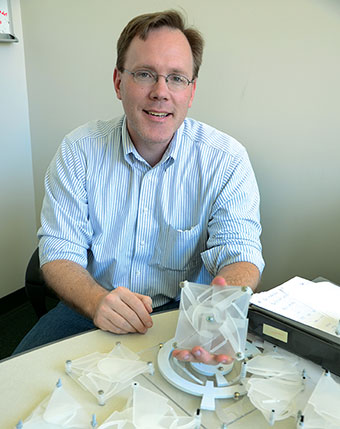Features
Shifting Shapes
| USF News

Photo by Katy Hennig | USF News
Craig Lusk’s job takes on many shapes.
The USF engineering professor uses a laser to cut sheets of polymer into dynamic, geometric pieces. He ties the shapes together in a way that could revolutionize some industries and lead to the invention of new products.
Lusk specializes in compliant mechanisms — the movement, or motion, the precision-cut shapes take on when they interact with each other.
“I have a surface that is very flexible in the plane. I can compress it, I can expand it, and I can shift from side to side in a motion called shearing,” he says. “So it’s very flexible to motions in the plane, but it’s very rigid if I have something out of plane.”
Lusk thinks the strength and flexibility of the surfaces could be used to develop improved body armor for police and the military. It could provide a range of motion that Lusk says is similar to the old chain-link armor worn by battling knights, but better because the specially designed springs allow for lightweight, flexible and extremely durable defense. The shapes could also be fashioned into a protective, but collapsible shield.
The possibilities for utilizing the shape-shifting surfaces, he says, are numerous. Other applications include robotics, containment structures and making antennas more flexible and responsive to locating signals.
Lusk has been working on the original design which he brought with him when he joined USF in August 2005. He secured a grant from the National Science Foundation in 2011 to continue his research. Now, he’s taken the concept to the next level, designing numerous versions, shapes and sizes of the surfaces.
“This is built based on the idea of lines bending in a plane, like on a flat surface. Now if you make things bend all up out of the plane, you can get things that are a little more complicated,” he says, demonstrating the movements.
Lusk’s design includes extremely precise geometrical calculations and laser cutting on a computer numeric control machine in order to perfectly align the surfaces. With the assistance of USF graduate student Paul Montalbano, Lusk has created dozens of the shapes, which are scattered around his office, on shelves and on filing cabinets.
They are shapes that could one day revolutionize the way things move.